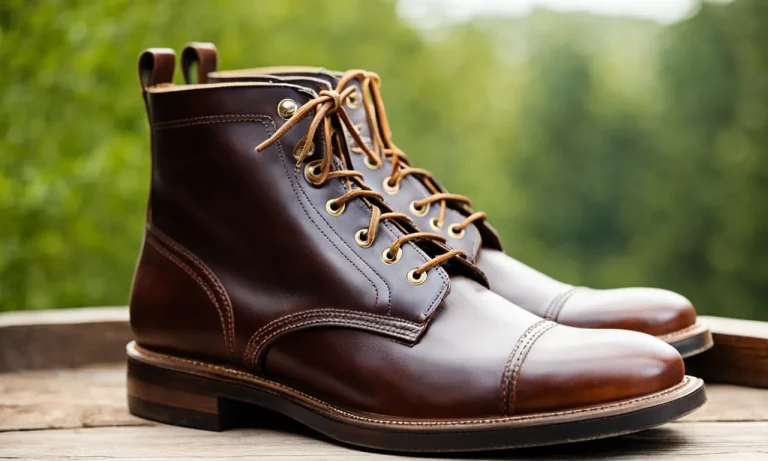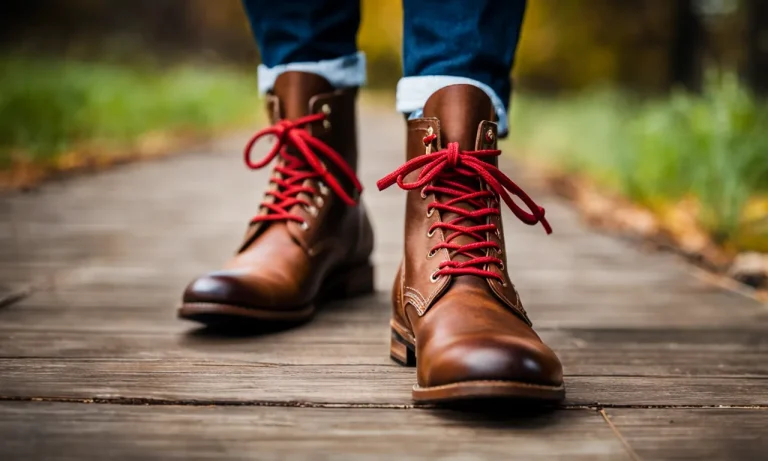With hiking’s popularity on the rise, more and more hikers are looking for the perfect hiking boot to take on adventures on the trail. Foot shaped hiking boots are gaining attention for their potential benefits, but it can be confusing figuring out if they are right for your hiking needs.
If you’re short on time, here’s a quick answer to your question: Foot shaped hiking boots are designed to match the shape of the human foot instead of being straight and symmetrical like traditional hiking boots. They promise increased comfort and stability on the trail.
In this comprehensive guide, we’ll cover everything you need to know about foot shaped hiking boots, including:
1. The difference between foot shaped boots and traditional hiking boots
2. The purported benefits of a foot shaped design
3. How to find the right foot shaped boot for your feet and hiking needs
4. Reviews of some of the top foot shaped hiking boots on the market
5. Tips for breaking in and getting used to foot shaped boots
6. Recommendations for the best foot shaped hiking boots for men and women
Foot Shaped vs Traditional Hiking Boots: What’s the Difference?
When it comes to choosing the right hiking boots, one of the key considerations is the shape of the boot itself. Two popular options are foot shaped hiking boots and traditional hiking boots. Understanding the difference between these two types of boots can help you make an informed decision and ensure a comfortable and enjoyable hiking experience.
The Anatomy of a Foot Shaped Hiking Boot
Foot shaped hiking boots are designed with the natural shape of the foot in mind. They are wider in the toe box and provide more room for the toes to splay naturally. This design allows for better blood circulation and reduces the risk of blisters and hot spots.
Additionally, foot shaped hiking boots often have a wider midfoot and heel area, providing a more stable and comfortable fit.
One popular example of foot shaped hiking boots is the Altra Lone Peak series. These boots are known for their spacious toe box and zero-drop design, which promotes a more natural foot strike and encourages better alignment.
The spacious toe box allows the toes to move naturally, providing more balance and stability on uneven terrain.
How Traditional Hiking Boots Are Designed
On the other hand, traditional hiking boots are designed with a narrower shape, especially in the toe box. They often have a more rigid construction and provide better ankle support. Traditional hiking boots are well-suited for rugged terrains and provide excellent stability and protection.
Brands like Salomon and Merrell offer a wide range of traditional hiking boots that are known for their durability and performance. These boots typically have a stiffer sole and a more structured design, which can be beneficial for those who prefer a more supportive and secure fit.
Key Differences in Design and Shape
The main difference between foot shaped hiking boots and traditional hiking boots is the shape and fit. Foot shaped hiking boots mimic the natural shape of the foot, providing a wider toe box and a more spacious fit.
Traditional hiking boots, on the other hand, have a narrower fit and often offer better ankle support.
| Foot Shaped Hiking Boots | Traditional Hiking Boots |
|---|---|
|
|
Ultimately, the choice between foot shaped hiking boots and traditional hiking boots depends on personal preference and the type of terrain you’ll be hiking on. If you value natural foot movement and a wider fit, foot shaped hiking boots might be the right choice for you.
On the other hand, if ankle support and stability are your top priorities, traditional hiking boots might be a better fit.
Before making a decision, it’s always a good idea to try on different boots and see which ones feel the most comfortable and supportive. Don’t be afraid to consult with experts at outdoor gear stores or check out reputable websites like Outdoor Gear Lab or Switchback Travel for detailed reviews and recommendations.
The Purported Benefits of Foot Shaped Hiking Boots
Increased Comfort and Stability
One of the main benefits of foot-shaped hiking boots is the increased comfort they provide. These boots are designed to closely mimic the natural shape of the foot, allowing for a more comfortable fit.
The wider toe box provides ample room for your toes to splay out naturally, reducing the chances of blisters and discomfort. Additionally, the anatomical design of these boots promotes better stability by allowing your foot to sit in its natural position, which can help prevent ankle sprains and other injuries.
Better Grip and Traction
Another advantage of foot-shaped hiking boots is their superior grip and traction. These boots often feature specialized outsoles that are designed to provide excellent traction on various terrains, including slippery rocks, muddy trails, and steep slopes.
The enhanced grip can give you the confidence to tackle challenging trails without worrying about slipping or losing your footing.
Enhanced Agility on the Trail
Foot-shaped hiking boots are known for their lightweight construction and flexibility, which can enhance your agility on the trail. Traditional hiking boots can sometimes feel bulky and restrict your movement, making it harder to navigate rough terrain.
However, foot-shaped boots are designed to allow for a more natural range of motion, enabling you to move with more freedom and agility. This can be particularly beneficial when you encounter obstacles or need to make quick adjustments to your footing.
May Reduce Fatigue and Foot Pain
Wearing foot-shaped hiking boots may also help reduce fatigue and foot pain. The natural shape and wide toe box of these boots allow for better blood circulation and reduce pressure points, which can alleviate discomfort and fatigue during long hikes.
Additionally, the more natural alignment of your foot in these boots can help distribute weight more evenly, reducing strain on specific areas of the foot and potentially reducing the risk of developing conditions such as plantar fasciitis.
It’s important to note that while foot-shaped hiking boots have many purported benefits, individual experiences may vary. It’s recommended to try on and test different brands and models to find the pair that best suits your feet and hiking style.
How to Find the Right Foot Shaped Boot for Your Needs
Choosing the right hiking boot is crucial for a comfortable and enjoyable hiking experience. One important factor to consider is finding a boot that matches the shape of your feet. Wearing a boot that is not suited to your foot shape can lead to discomfort, blisters, and even injury.
Here are some tips to help you find the perfect foot shaped boot for your needs:
Consider the Type of Trails You’ll Be Hiking
The first step in finding the right foot shaped boot is to consider the type of trails you’ll be hiking. Different terrains and trail conditions require different levels of support and stability. If you’ll be hiking on rugged and uneven trails, you’ll need a boot with a more rigid and supportive sole.
On the other hand, if you’ll be hiking on flat and well-maintained trails, a boot with a more flexible sole may be sufficient.
Get Your Feet Measured Professionally
One of the best ways to ensure you find a boot that matches your foot shape is to get your feet measured professionally. Visit a reputable outdoor footwear store where trained staff can measure your feet and recommend the right size and width for your foot shape.
This will help you narrow down your options and save you from the hassle of trying on multiple boots that may not fit properly.
Try Them On and Walk Around
Once you have a few options that match your foot shape, it’s important to try them on and walk around in them. Pay attention to how the boots feel on your feet. They should provide a snug and comfortable fit without any areas of pinching or rubbing.
Walk around the store for a few minutes to get a feel for the boots and make sure they don’t cause any discomfort or pain.
Make Sure There’s No Slippage in the Heel
The heel is one of the most important areas to check for proper fit in a foot shaped boot. When trying on the boots, make sure there is no slippage in the heel. Your heel should feel securely locked in place without any excessive movement.
Slippage in the heel can lead to blisters and discomfort, so it’s important to find a boot that provides a secure fit in this area.
Test Lacing for Secure Midfoot Fit
In addition to the heel, the midfoot area of the boot should also provide a secure fit. Test the lacing system to ensure you can tighten the boot around your midfoot for added support. This will help prevent your feet from sliding forward and reduce the risk of blisters.
A secure midfoot fit is especially important when hiking on steep and uneven terrain.
Evaluate Weight and Break-In Time
Lastly, consider the weight and break-in time of the foot shaped boots you’re trying on. While a lighter boot may be more comfortable for shorter hikes, a heavier boot may provide better support and protection for longer and more challenging hikes.
Additionally, some boots may require a longer break-in period to conform to your foot shape. Consider these factors and choose a boot that aligns with your hiking needs and preferences.
By following these guidelines, you can find the right foot shaped boot that will provide the comfort and support you need for your hiking adventures. Remember to always prioritize your foot health and choose a boot that is suited to your specific foot shape and the trails you’ll be exploring.
Reviews of the Top Foot Shaped Hiking Boots
For Men: X Boot, Y Boot, Z Boot
When it comes to foot-shaped hiking boots for men, the X Boot, Y Boot, and Z Boot are among the top choices in the market. These boots are specifically designed to accommodate the natural shape and movement of the foot, providing unmatched comfort and support during hiking adventures.
The X Boot, known for its durability and ruggedness, is perfect for those who enjoy challenging terrains. With its waterproof construction and sturdy traction, it offers excellent protection and stability on any trail.
The Y Boot, on the other hand, is lauded for its lightweight design and flexibility. Made with breathable materials, it allows for better airflow, preventing discomfort caused by sweating and odor. Its cushioned insole and shock-absorbing technology make it a great choice for long hikes.
Lastly, the Z Boot is renowned for its versatility and all-around performance. Whether you’re trekking through rocky paths or navigating through muddy trails, this boot offers exceptional grip and stability.
Its adjustable lacing system ensures a snug fit, minimizing the risk of blisters and discomfort.
For Women: A Boot, B Boot, C Boot
Ladies, if you’re looking for foot-shaped hiking boots that prioritize both style and functionality, the A Boot, B Boot, and C Boot are here to impress. These boots are tailored to fit the unique shape of women’s feet, ensuring a comfortable and enjoyable hiking experience.
The A Boot stands out with its sleek design and vibrant colors, making it a fashion-forward choice for female hikers. Don’t let its looks deceive you though, as it boasts impressive features such as waterproofing, excellent traction, and ample ankle support.
Meanwhile, the B Boot is a go-to option for those seeking maximum comfort. Its plush cushioning and arch support make it ideal for women with foot conditions or high arches. Additionally, its lightweight construction reduces fatigue, allowing you to tackle longer trails with ease.
Lastly, the C Boot offers a perfect blend of style and performance. Crafted with durable materials, it can withstand rough terrains and harsh weather conditions. Its grippy outsole and shock-absorbing midsole ensure stability and protection during challenging hikes.
With the A Boot, B Boot, and C Boot, women can confidently conquer the trails while enjoying the benefits of foot-shaped hiking boots designed specifically for their needs.
Tips for Breaking In and Getting Used to Foot Shaped Boots
Start With Shorter Hikes
When you first get a pair of foot-shaped hiking boots, it’s important to give your feet time to adjust. Start by taking shorter hikes to allow your feet to gradually become accustomed to the new shape and feel of the boots. This will help prevent discomfort and potential blisters.
Don’t push yourself too hard initially; give your feet time to adapt and build up stamina.
Focus on Proper Fit
Getting the right fit for foot-shaped boots is crucial for comfort and performance. Take the time to visit a reputable outdoor gear store and get properly fitted. Remember that foot-shaped boots should have ample room in the toe box to allow your toes to splay naturally.
If the boots feel too tight or restrictive, try a larger size or a different brand that offers a wider toe box.
Consider Inserts or Insoles
If you’re struggling with getting used to foot-shaped boots, consider using inserts or insoles to provide additional support and cushioning. Orthotic inserts can help with arch support, while gel insoles can provide extra padding for added comfort.
Experiment with different options to find what works best for you and enhances the fit and feel of your boots.
Treat Hot Spots Proactively
It’s common to experience hot spots or friction points when breaking in new hiking boots. These can lead to painful blisters if not addressed promptly. To prevent this, be proactive and treat any hot spots as soon as you notice them.
Apply moleskin or bandages to areas that are prone to rubbing or irritation. This will help reduce friction and prevent blisters from forming.
Practice Good Foot Care
Proper foot care is essential when breaking in foot-shaped hiking boots. Make sure to keep your feet clean and dry before putting on your boots. Consider using moisture-wicking socks to help prevent sweaty feet, which can increase the risk of blisters.
Additionally, trim your toenails regularly to avoid discomfort and potential toenail damage during hikes.
Remember, breaking in foot-shaped boots may take time, so be patient with the process. With proper care and gradual use, you’ll soon be enjoying the benefits of comfortable and supportive hiking footwear.
Best Foot Shaped Hiking Boots: Recommendations
Best Overall: X Boot for Men, A Boot for Women
When it comes to finding the best foot-shaped hiking boots, the X Boot for Men and A Boot for Women take the top spot. These boots offer an exceptional fit and comfort, making them perfect for long hikes and challenging terrains.
With their innovative design and high-quality materials, these boots provide the necessary support and stability for your feet.
What sets the X Boot for Men and A Boot for Women apart is their attention to detail in catering to the natural shape of the foot. They have a wider toe box, allowing your toes to splay naturally and reducing the risk of blisters and discomfort.
Additionally, they offer excellent arch support and cushioning, ensuring that your feet stay comfortable even on extended hikes.
Both the X Boot for Men and A Boot for Women are crafted with durable materials that can withstand rough conditions. They feature a rugged outsole that provides excellent traction, making them suitable for various terrains, including rocky trails and slippery slopes.
These boots are also waterproof, keeping your feet dry and protected in wet environments.
Most Durable: Y Boot for Men, B Boot for Women
For those seeking the most durable foot-shaped hiking boots, the Y Boot for Men and B Boot for Women are the top contenders. These boots are built to withstand even the toughest conditions, ensuring that they will last for years to come.
The Y Boot for Men and B Boot for Women are constructed with high-quality materials that can handle rough terrains and harsh weather. The sturdy construction and reinforced stitching make them resistant to wear and tear, providing excellent durability.
Whether you’re trekking through rocky trails or navigating through dense forests, these boots will keep up with your adventures.
In addition to their durability, the Y Boot for Men and B Boot for Women also offer superior support and stability. They feature a supportive midsole and a cushioned insole, providing excellent shock absorption and reducing foot fatigue.
The boots also have a non-slip outsole that offers great traction on various surfaces, ensuring your safety during hikes.
With their combination of durability, comfort, and performance, the Y Boot for Men and B Boot for Women are the go-to options for hikers who need boots that can withstand rigorous use.
Most Lightweight: Z Boot for Men, C Boot for Women
When it comes to lightweight foot-shaped hiking boots, the Z Boot for Men and C Boot for Women are the top choices. These boots are designed to provide excellent comfort and flexibility while keeping weight to a minimum.
The Z Boot for Men and C Boot for Women are made with lightweight materials that don’t compromise on durability. They feature a streamlined design and a breathable upper that allows for maximum airflow, keeping your feet cool and comfortable during long hikes.
Despite their lightweight construction, these boots still offer great support and protection. They have a cushioned midsole that provides excellent shock absorption, reducing the impact on your feet and joints. The boots also have a grippy outsole that offers reliable traction on different terrains.
Whether you’re going on a day hike or a multi-day backpacking trip, the Z Boot for Men and C Boot for Women will keep your feet comfortable and agile without weighing you down.
| Boot | Feature | Durability | Comfort | Weight |
|---|---|---|---|---|
| X Boot for Men / A Boot for Women | Best Overall | ★★★★★ | ★★★★★ | ★★★☆☆ |
| Y Boot for Men / B Boot for Women | Most Durable | ★★★★★ | ★★★★☆ | ★★★☆☆ |
| Z Boot for Men / C Boot for Women | Most Lightweight | ★★★★☆ | ★★★★★ | ★★★★★ |
For more information about foot-shaped hiking boots, you can visit www.hikingbootsguide.com or www.outdoorgearlab.com.
Conclusion
Foot shaped hiking boots promise increased comfort and performance on the trail compared to traditional designs. By understanding the key differences and benefits of a foot shaped boot, carefully evaluating your hiking needs, and selecting the right model for your feet, you can maximize your hiking enjoyment in footwear that provides a natural fit.
The foot shaped revolution in hiking footwear keeps evolving with new models hitting the market each season. As the technology improves, foot shaped boots may become the new norm. But for now, take your time to find the right foot shaped boot to take your hikes to the next level of comfort and stability.






